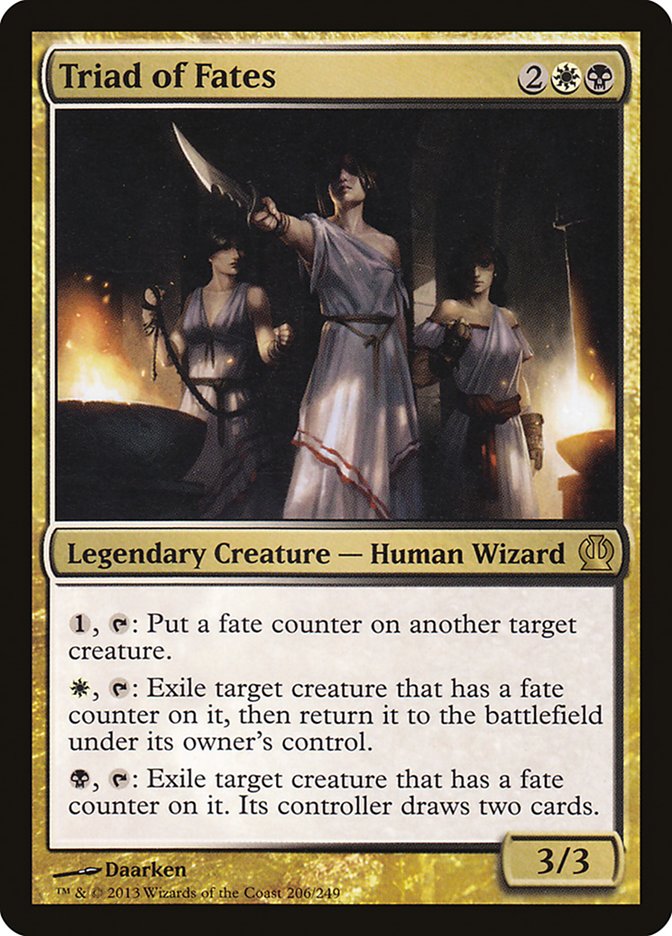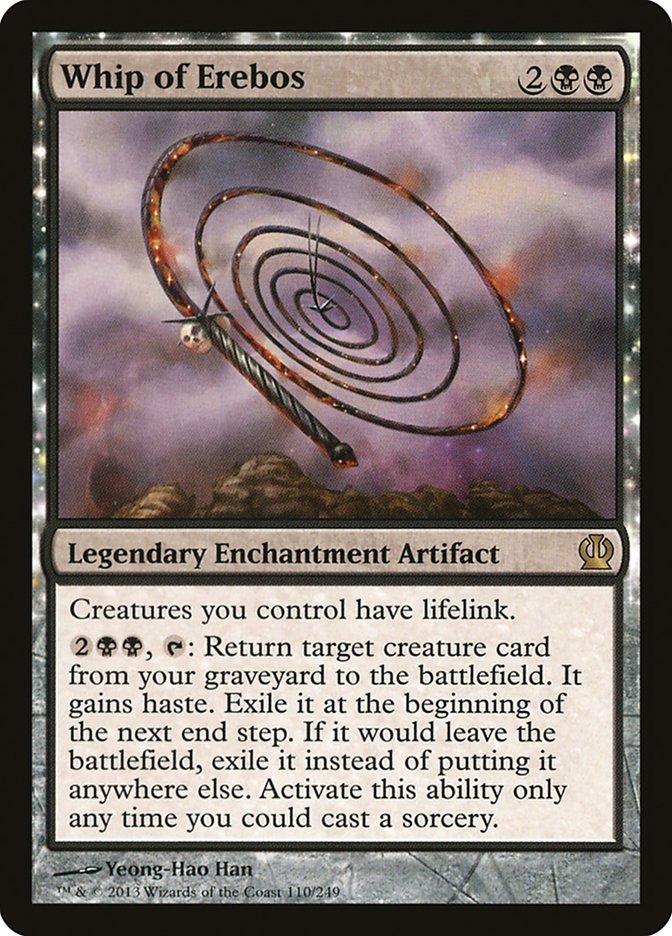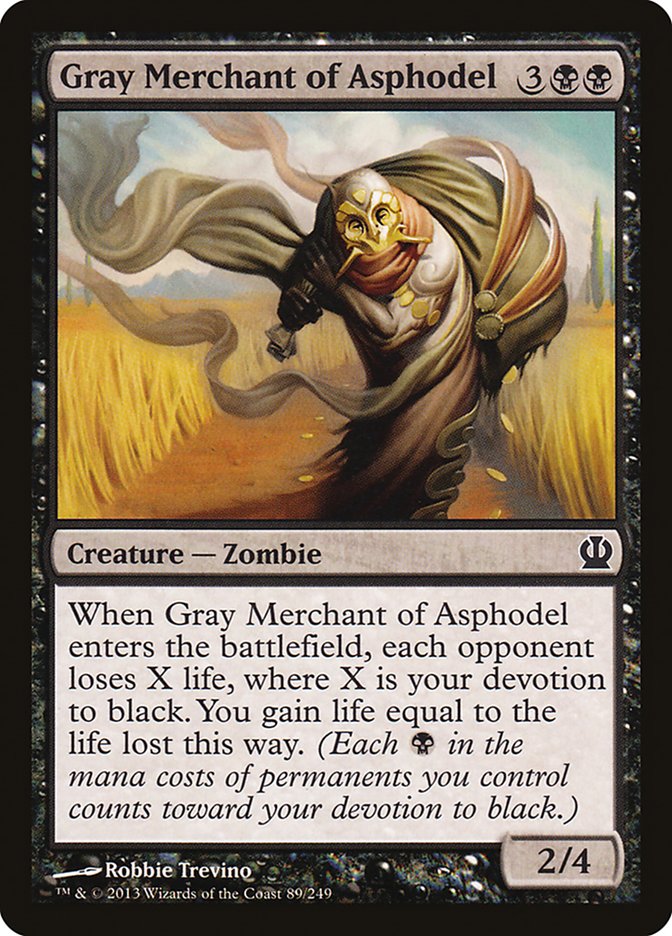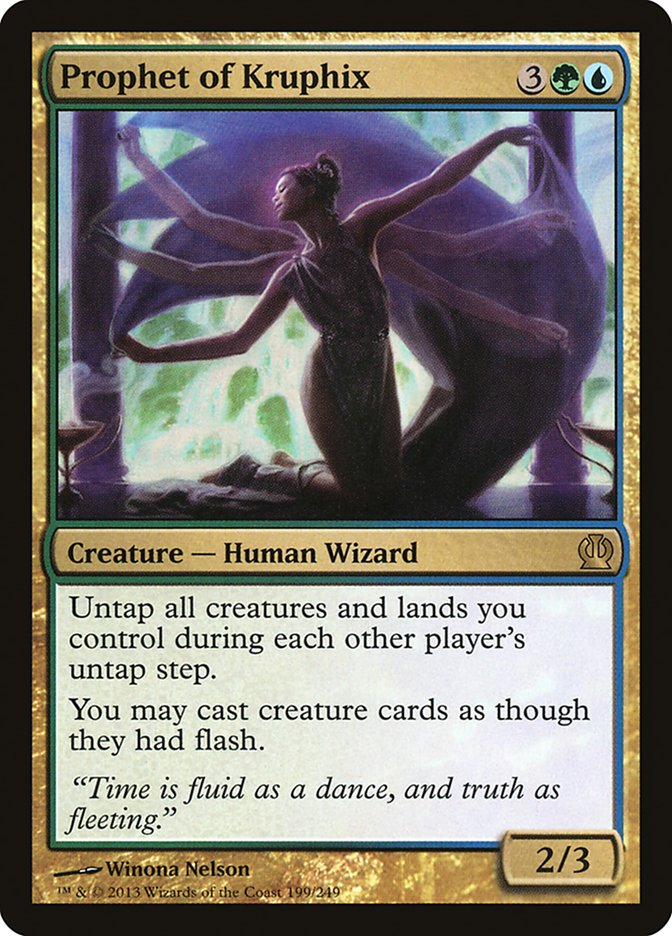I learned a lot of things in Dublin. How unreal Thassa, God of the Sea is, that Orzhov was the deck I wanted to play at the Pro Tour, how to drive a stick on the left side of the road, how masterful of chefs Kai Budde and Gabriel Nassif are.
Not the least of all of these lessons was how to draft Theros. When I showed up in Dublin, I didn’t know the first thing about Theros Limited. I sat down at a table full of Hall of Famers and World Championship competitors to get my first taste . . .
And, well, let’s just say that they smacked the taste out of my mouth.
0-3
0-3
0-3
When I start a format 0-9, I know it’s going to be good! To begin with, it means it is a challenge, and I love a challenge. If everyone knows exactly what’s going on from the jump, then how much benefit am I going to get from digging deeper? Besides, if these guys are beating me this badly, that suggests there is a lot of skill in the format, and they are the perfect ones to teach me!
It wasn’t until my sixth draft in the castle that I finally managed a winning record, but I could feel my grasp of the format improving. It is not every format that I want to do more than 25 drafts, but I am not even close to bored of Theros Limited. Getting to draft multiple times a day was great, particularly since we had enough people that no two drafts had the same eight participants. Additionally, after each draft we discussed what worked, what didn’t, and what we learned. This made each draft so much more fruitful than if we had just been playing nonstop games.
It’s worth noting that when the same eight people jam draft after draft, there is a very real risk of getting very inbred quickly as well as not getting to try out the full range of possibilities (due to someone’s preferences making the strategy they like appear less draftable since you are always fighting them). If you’re ever in a testing spot where you want to try to learn a new Draft format quickly but don’t have more than eight people, I recommend a couple things.
- Make novelty a priority. This is not to say that people should intentionally split up what they’re going to play, but there were definitely times at the castle where most of us made picks we normally wouldn’t have in order to try out more strategies. For instance, I hadn’t drafted green yet five drafts in. I was faced with the option of Griptide or Nessian Asp. While I would normally rather lead with the Griptide in that spot to leave me more options, I went with the Asp to force myself to learn more about the other archetypes. Forcing myself to expand my range paid off big because, sure enough, both of my PT decks were Nessian Asp decks.
- Consider splicing in some Magic Online. Magic Online is a notoriously dubious place to test Limited before a big event, as the online drafts are just so much softer than in competitive play at Pro Tours and Grand Prix. I can’t help but wonder what Magic would be like if it had skill-based matchmaking like League of Legends and Call of Duty.
- Talk about each player’s draft, how it went, and what they learned. This greatly accelerates your gaining of knowledge about a format and helps balance out biases a little. It is still way better if everyone tries everything over time, but at least you can learn what the guys that drafted Deck A experienced.
Over the course of our week in the castle, Jon Finkel, Paul Rietzl, Matt Sperling, William Jensen, Reid Duke, and Sam Black each taught me at least one major lesson that I used during the event. Last week people asked about those lessons, and while I don’t often write about Limited, I’ve been enjoying drafting Theros enough to make an exception.
Where to start?
To me, the most memorable and useful Limited preparation we did was the team meeting in which we discussed every rare and mythic in the set. This meeting was recorded by SCG’s film crew, so hopefully we will be seeing that video in the near future. [Editor’s Note: Quite soon in fact!] I imagine that getting a sneak peek inside that kind of discussion is a better tool for improving at the format quickly than just about anything else I can think of.
This was an experiment proposed by Paul Rietzl and Matt Sperling during our last full day at the castle. Their theory was that while we had all done enough drafts to get a feel for most of the commons and uncommons as well as the regular archetypes, it’s just not possible to get a chance to play with each and every rare and mythic in the set. However, all thirteen of us combined had experiences with every single rare and mythic multiple times.
The exercise involved one of us reading the name of each rare and mythic one by one. Reid Duke would classify the card either:
- Bomb (you’d pick it over any common or uncommon)
- Great, but not a bomb (there are some uncommons you’d pick over it)
- Good, not great (there are some commons you’d pick over it)
- Playable, but not good (you wouldn’t always play it)
- Unplayable
Then, if anyone disagreed, they would speak up and share their experiences. Often there was disagreement, but this let us filter out the uninteresting discussions, such as Polukranos and Elspeth. Yes, they are awesome cards and you are going to windmill slam them, but what is there to talk about? There are plenty of rares and mythics you’d never pass pack 1 pick 1, so ordering them isn’t particularly useful (particularly since there are no foils at the Pro Tour; they are replaced with random commons).
The interesting discussions came from cards like Triad of Fates. That is the exact type of card that could easily be a windmill slam first pick or only so-so depending on the format. In testing it is massively valuable to err on the side of picking the rare whenever you are deciding between two cards and don’t know which to take. Gaining experience with rares is much harder to come by than commons and uncommons. Sam in particular drafted a lot of the strange and fringe archetypes, which helped us learn a lot, particularly about fringe archetypes that required a key rare to make work.
Our discussion made it clear that Triad of Fates is a great card once it is in your deck but B/W is probably the worst two-color combination. Once you’re B/W, Triad of Fates is definitely better than Wingsteed Rider; however, it is not so much better that you want to move in on it pack 1 and have to play such a weak color combo.
Conversely, Whip of Erebos is a card that many were very confused about regarding the power. I had drafted it once already in a U/B deck, where it was good but not great, but I didn’t have a lot of creatures. In a later draft, I was already green but open for my second color. I was faced with the decision of Whip of Erebos or Nessian Asp and asked Huey for his take—should I take a great first pick in my color and keep my options open or move in on black for the Whip?
His response? Whip, not close, particularly since it is at its best in B/G due to large creatures to lifelink and cards like Commune with the Gods to fill your graveyard. The result? My first winning record! Throughout the weekend Huey was probably the most valuable tactical advisor regarding pick decisions and what cards to cut from a deck. Hearing piece of advice after piece of advice from him allowed me to start to form a picture of the pattern in his advice as well as compile a database to draw from when faced with similar problems in the future.
Kai was one of the doubters initially, particularly after facing it with his U/B Control deck (which is not its best matchup). After hearing Huey and Owen praise it so strongly, he had a chance to pick it up, though it meant switching colors. He wanted to try it and see what all of the fuss was about. Sure enough, he became a believer and avoided a situation at the PT where he passes a bomb simply because of having no experience with the card.
Why not just always roll the dice and pick the rare? Often we are talking about picking it over some top-notch commons and uncommons. That is not a trivial opportunity cost.
Gray Merchant of Asphodel was a card that I and many others initially underestimated. While I knew the card was good, I didn’t realize just how good, and I didn’t have a lot of chances to play with it since so many people were fighting for black all the time. The lessons here were two-fold.
First, Gray Merchant is the best common by a lot, and the main reason why black is the “best color.” Even when I didn’t play black, having an understanding of how highly people valued the card let me read signals better and understand what was going on in the draft.
Second, I learned that I liked taking black early but being able to walk away. It is very tempting to want to go all in on Gray Merchant and try to force it even when it is getting cut. For instance, in Urza’s Sage it was definitely the right strategy to play black even if there were four other players at the table drafting it. While black is good in Theros, you don’t want to end up with a deck full of Fleshmad Steeds, Felhide Minotaurs, and Viper’s Kisses when you could have gotten away from your Gray Merchant and just picked a bunch of Wingsteed Riders and Battlewise Hoplites.
A sort of corollary to the strength of black is the relative weakness of red. I think all five colors are very playable in Theros, but there is a weakest one, which is red. In fact, I think red is the weakest by a bigger margin than black is the strongest. It is very unclear to me how much better than blue black is, and frankly I really like white and green. Red, on the other hand, needs to have several people’s worth of red and opening a pretty sick red card to get me in. There are some great red cards that can make me want to do this, but the bar is much higher than for other colors.
Theros Limited is really kind of like a cousin to Rise of the Eldrazi—except less weird. Most notably, instead of being a largely combo-based format, 2/2s for two are actually playable. Still, the format involves a lot of making giant threats that take over the game as well as some pretty synergistic interactions.
Interestingly, this takes place in the same world as one that is overrun with combat tricks. Learning what all of these tricks are and how to play around them was a crucial skill that I acquired largely from Jon, Huey, and Owen. For instance, that there are so many ways for white decks to give their creatures plus two toughness makes it easier to actually play around them. Additionally, knowing that a single black mana can only mean Boon of Erebos (or Dark Betrayal if you are black) is invaluable to know.
This is certainly not something unique to this format, but it is a format where this is more important than average. The number of good tricks is quite high, and heroic encourages people to play more tricks than they normally would.
As far as specific archetypes go, I agree with many of the others in the castle that it is better to stay open and pick what comes. Still, it was valuable watching drafts from people with more radical evaluations like Tom Martell, who basically forces White Heroic Aggro every time.
Reid drafted a lot of Five-Color Green decks in the castle and was doing quite well with them. I decided to take stock and get his thoughts on why he was drafting the way he was, how strongly he wanted to do that versus just playing two colors, and which cards were important to pulling it off. His thoughts and ideas on the archetype were invaluable in the Limited portion of the Pro Tour, where I ended up drafting Five-Color Green in the first draft of the event.
What he taught me was that when drafting green early prioritizing Opaline Unicorn, Nylea’s Presence, and to a lesser extent Traveler’s Amulet and Unknown Shores has a relatively small cost and gives us some really valuable options. Theros Booster Draft is a format where you always get way more playables than you need (assuming you don’t completely trainwreck and switch colors a couple times). The opportunity cost of passing up some random Pheres-Band Centaurs or even a Vulpine Goliath in order to snag a couple extra mana fixers is just not that high. There is no shortage of playables and certainly no shortage of expensive green cards.
At the PT I was basically drafting a Mono-Green Devotion deck. I kept my options open, and eventually a pack 3 Celestial Archon moved me into white as a second color. I needed the five-color fixers anyway (Nylea’s Presence is a great Green Devotion enabler), so I ended up splashing a single Polis Crusher, a Griptide, and a sideboarded Read the Bones.
It’s not that you look to force Five-Color Green; it’s just that it lets you play whatever bombs you open in packs 2 and 3. Additionally, it plays into the strategy that most of us adopted of keeping our colors open in the first few packs. In some formats this means picking colorless cards higher. What I mean here is being willing to walk away from some early picks.
For instance, I could see first picking Gray Merchant of Asphodel, second picking Griptide, and then third picking Lightning Strike. It’s not that we are trying to bounce all over the place; it’s just that this is a format that rewards flexibility and figuring out what your neighbors are setting up for you. There’s never a shortage of playables, so “wasting” a few picks is not that bad. However, the best cards are a lot better than the normal cards, so making sure that you can take advantage of that Prophet of Kruphix that unexpectedly got passed to you can be worth more than “forcing black” by taking a Fleshmad Steed to make it clear you are serious about your Gray Merchant.
Forcing works better in formats where the card pool isn’t this deep all the way around because then the people sitting next to you can actually be scared to play chicken with you. In Theros, even if they drive face first into you and play U/B downstream of your U/B deck, they are going to get enough playables.
I ended up 3-0ing that draft to start the tournament off right and couldn’t have done it without Reid’s wisdom.
In my draft to start day 2, again I found myself drafting green, leaving my other color open between blue and white. As always, I drafted a few five-color fixers in case things broke that way. This time, however, I decided my deck wanted to be a tempo-oriented U/G deck fueled by a Polukranos, World Eater; Nylea, God of the Hunt; and a surprising amount of blue heroic cards. While I had the fixers, I left my Heliod, God of the Sun and a few black cards in the sideboard. Fortunately for me, Reid had taught me not only how to get into Five-Color Green but also how to get out of it.
I ended up going 2-1 in that draft, losing a close one to Luis Scott-Vargas. He played a Two-Headed Cerberus on turn 3, which I followed with a Polukranos. He countered with a Dragon Mantle, an Aqueous Form, and an Ordeal of Purphoros, which obviously put a little bit of pressure on me. While I came close thanks to a Wavecrash Triton, his combination of Griptide and Lightning Strike gave him the time he needed to survive at one life and then counterattack for the kill. While it would have been nice to win that one, I couldn’t be too disappointed with a 5-1 showing in Draft and was once again reminded of the value of good Limited preparation, which includes discussion and not just drafting and playing.
Anyway, thanks for giving me a day to talk Theros Limited. I haven’t liked a Limited format this much since Innistrad (other than Modern Masters), and hopefully the high-level ideas on how to approach Limited preparation are of value. For actual pick orders, signals, archetypes, and so on, there is no shortage of other options, so I highly recommend checking them out. Ari Lax, Paul Rietzl, and Sam Black are three I’d look for in particular.
Ok, Monday . . . back to brewing!
Patrick Chapin
“The Innovator”





